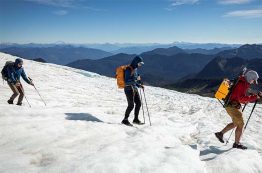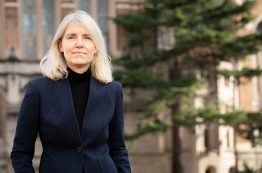Glacier ice is usually thought of as brittle. You can drill a hole in an ice sheet, like into a rock, and glaciers crack and calve, leaving behind vertical ice cliffs. But new University of Washington research shows that glaciers are also slightly compressible, or squishy. This compression over the huge expanse of an ice sheet — like Antarctica or Greenland — makes the overall ice sheet more dense and lowers the surface by tens of feet compared to what would otherwise be expected, according to results published Jan.
Read more at UW News »UW Environment scientist named 2021 AAAS fellow
Emily Carrington, resident scientist at the UW’s Friday Harbor Laboratories, was named a AAAS Fellow, according to a Jan. 26 announcement by the American Association for the Advancement of Science. She is among 564 new fellows from around the world elected in 2021, who are recognized for “their scientifically and socially distinguished achievements” in science and engineering. Carrington is honored for her research contributions in biomechanics and ecophysiology, as well as efforts to promote diversity and inclusion in science.
Read more at UW News »In conversation with Dean Maya Tolstoy
Earlier this month, marine geophysicist Maya Tolstoy joined the University of Washington as the Maggie Walker Dean of the College of the Environment. Over her more than 30-year career as a researcher, professor and administrator, Dean Tolstoy has dedicated herself to furthering our understanding of the fundamental processes of our planet and advancing diversity, equity and inclusion in academia. The College welcomes its new dean at a pivotal time, when the impacts of the climate crisis are growing more visible each year and the need for equity and justice in our field is clearer than ever.
Read more »Shift work helps marine microbes share scarce ocean resources
Though they may be small, microorganisms are the most abundant form of life in the ocean. Marine microbes are responsible for making roughly half of the organic carbon that’s usable by life. Many marine microbes live near the surface, depending on energy from the sun for photosynthesis. Yet between the low supply of and high competition for some key nutrients, like nitrogen, in the open ocean, scientists have puzzled over the vast diversity of microbial species found there.
Read more at UW News »Bubbles of methane rising from seafloor in Puget Sound
The release of methane, a powerful greenhouse gas responsible for almost a quarter of global warming, is being studied around the world, from Arctic wetlands to livestock feedlots. A University of Washington team has discovered a source much closer to home: 349 plumes of methane gas bubbling up from the seafloor in Puget Sound, which holds more water than any other U.S.
Read more at UW News »





